SOCA6640 Briefing Document: Mixed Methods Research Application
VerifiedAdded on 2023/06/11
|12
|3676
|264
Report
AI Summary
This briefing document explores mixed methods research, a methodology integrating qualitative and quantitative data for comprehensive analysis. It discusses the types of mixed-method designs, including sequential explanatory, sequential exploratory, concurrent triangulation, and concurrent nested designs, highlighting their strengths and limitations. The document emphasizes the importance of fieldwork principles for effective data collection and analysis within the context of the Central Emergency Response Fund (CERF). It also addresses the challenges and principles of data analysis, stressing the need for averaging, comparison, and proportional reasoning to derive meaningful results. This briefing document provides a detailed overview for CERF to enhance their understanding and application of mixed methods research in addressing global funding needs, with the aim of improving their working functions and achieving valuable outcomes in humanitarian operations worldwide. Desklib offers a wealth of similar resources and solved assignments to aid students in their studies.
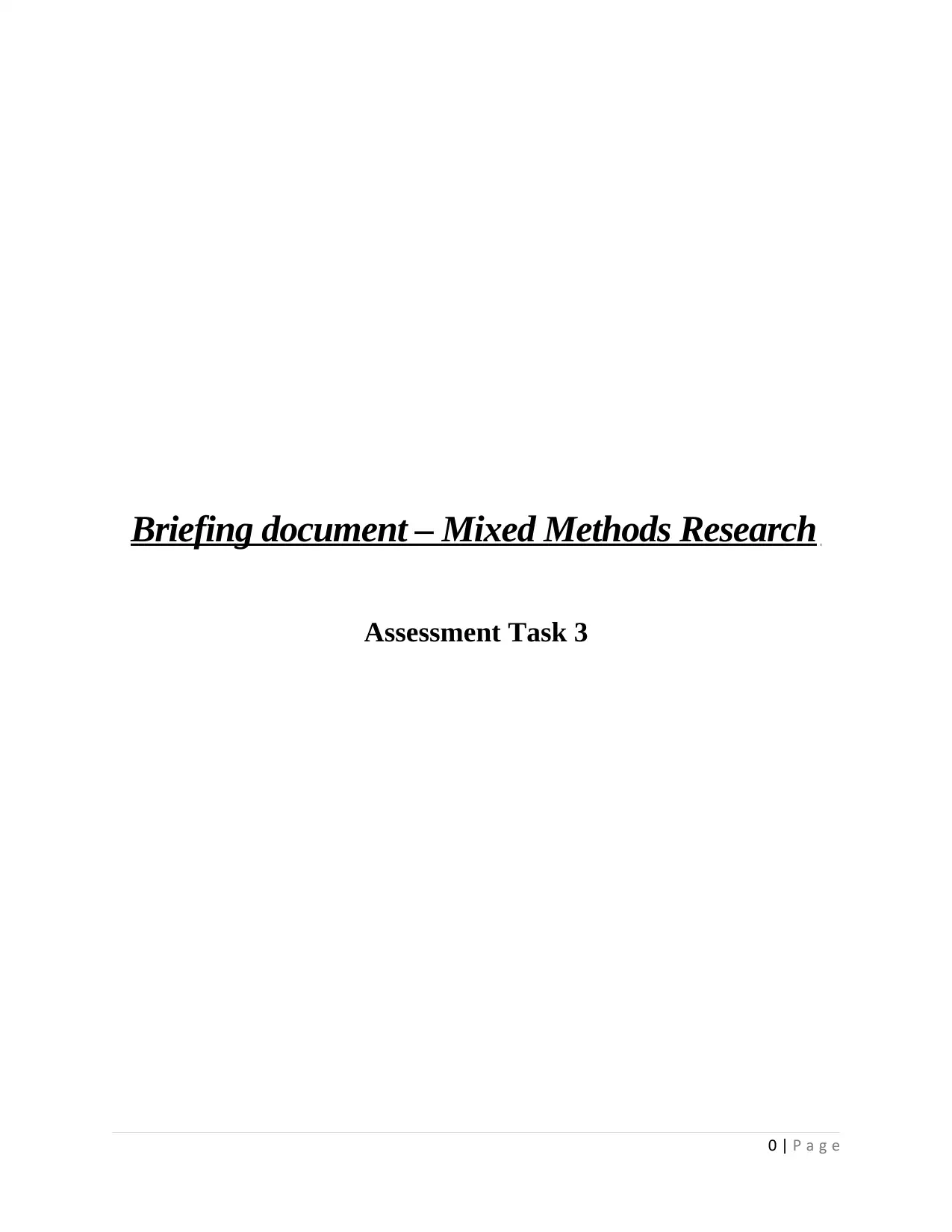
Briefing document – Mixed Methods Research
Assessment Task 3
0 | P a g e
Assessment Task 3
0 | P a g e
Paraphrase This Document
Need a fresh take? Get an instant paraphrase of this document with our AI Paraphraser

Table of Contents
Introduction.................................................................................................................................................2
Mixed method research...............................................................................................................................2
Qualitative data........................................................................................................................................2
Quantitative data......................................................................................................................................2
Mixed method..........................................................................................................................................2
When and why it is used?........................................................................................................................3
Type of strategies and design......................................................................................................................3
Sequential explanatory design.................................................................................................................3
Sequential exploratory design..................................................................................................................3
Concurrent Triangulation........................................................................................................................4
Concurrent nested....................................................................................................................................4
Strength of Mixed method research.............................................................................................................4
Limitations of Mixed method research........................................................................................................5
Principle of fieldwork..................................................................................................................................5
Analysis.......................................................................................................................................................6
Reporting.....................................................................................................................................................7
Conclusion...................................................................................................................................................8
References...................................................................................................................................................9
1 | P a g e
Introduction.................................................................................................................................................2
Mixed method research...............................................................................................................................2
Qualitative data........................................................................................................................................2
Quantitative data......................................................................................................................................2
Mixed method..........................................................................................................................................2
When and why it is used?........................................................................................................................3
Type of strategies and design......................................................................................................................3
Sequential explanatory design.................................................................................................................3
Sequential exploratory design..................................................................................................................3
Concurrent Triangulation........................................................................................................................4
Concurrent nested....................................................................................................................................4
Strength of Mixed method research.............................................................................................................4
Limitations of Mixed method research........................................................................................................5
Principle of fieldwork..................................................................................................................................5
Analysis.......................................................................................................................................................6
Reporting.....................................................................................................................................................7
Conclusion...................................................................................................................................................8
References...................................................................................................................................................9
1 | P a g e
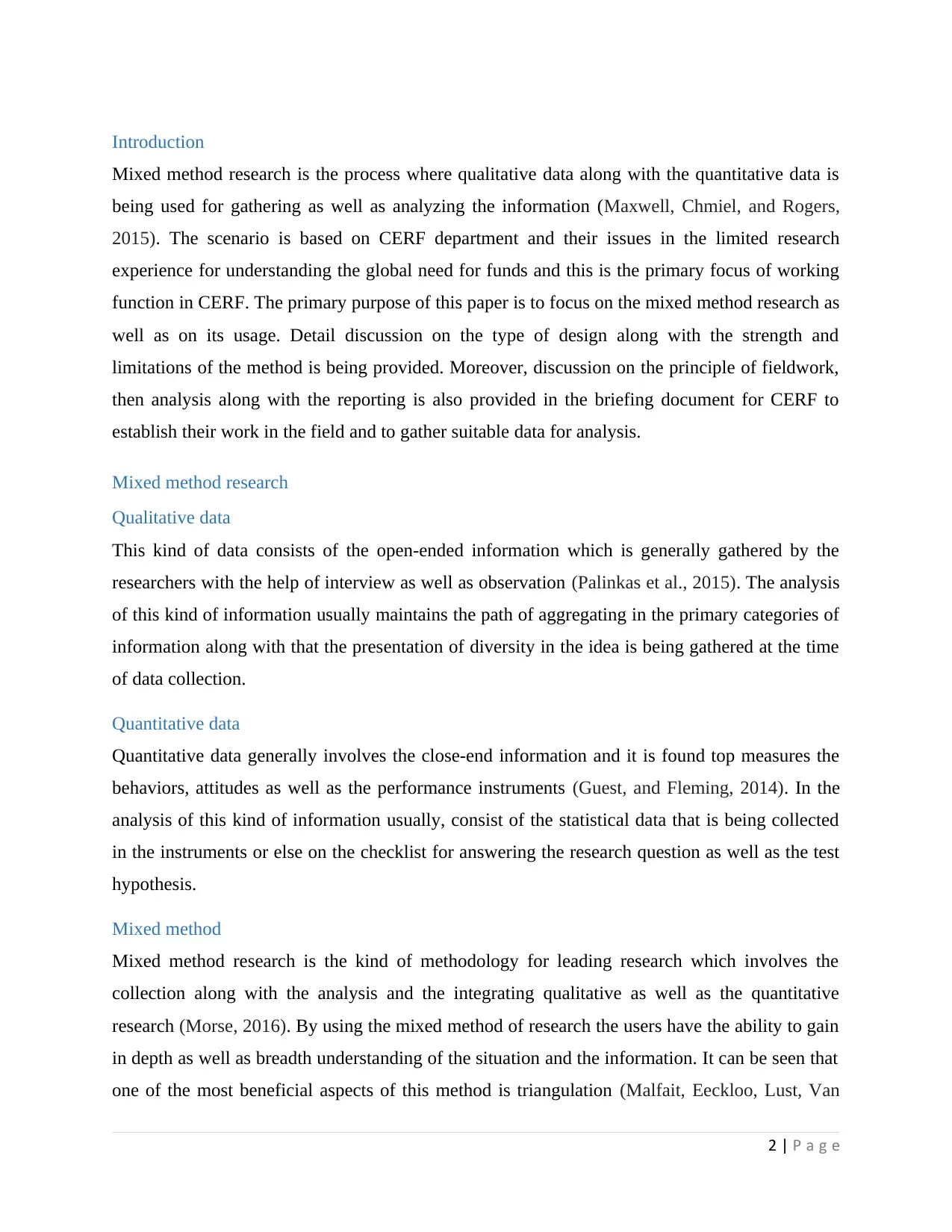
Introduction
Mixed method research is the process where qualitative data along with the quantitative data is
being used for gathering as well as analyzing the information (Maxwell, Chmiel, and Rogers,
2015). The scenario is based on CERF department and their issues in the limited research
experience for understanding the global need for funds and this is the primary focus of working
function in CERF. The primary purpose of this paper is to focus on the mixed method research as
well as on its usage. Detail discussion on the type of design along with the strength and
limitations of the method is being provided. Moreover, discussion on the principle of fieldwork,
then analysis along with the reporting is also provided in the briefing document for CERF to
establish their work in the field and to gather suitable data for analysis.
Mixed method research
Qualitative data
This kind of data consists of the open-ended information which is generally gathered by the
researchers with the help of interview as well as observation (Palinkas et al., 2015). The analysis
of this kind of information usually maintains the path of aggregating in the primary categories of
information along with that the presentation of diversity in the idea is being gathered at the time
of data collection.
Quantitative data
Quantitative data generally involves the close-end information and it is found top measures the
behaviors, attitudes as well as the performance instruments (Guest, and Fleming, 2014). In the
analysis of this kind of information usually, consist of the statistical data that is being collected
in the instruments or else on the checklist for answering the research question as well as the test
hypothesis.
Mixed method
Mixed method research is the kind of methodology for leading research which involves the
collection along with the analysis and the integrating qualitative as well as the quantitative
research (Morse, 2016). By using the mixed method of research the users have the ability to gain
in depth as well as breadth understanding of the situation and the information. It can be seen that
one of the most beneficial aspects of this method is triangulation (Malfait, Eeckloo, Lust, Van
2 | P a g e
Mixed method research is the process where qualitative data along with the quantitative data is
being used for gathering as well as analyzing the information (Maxwell, Chmiel, and Rogers,
2015). The scenario is based on CERF department and their issues in the limited research
experience for understanding the global need for funds and this is the primary focus of working
function in CERF. The primary purpose of this paper is to focus on the mixed method research as
well as on its usage. Detail discussion on the type of design along with the strength and
limitations of the method is being provided. Moreover, discussion on the principle of fieldwork,
then analysis along with the reporting is also provided in the briefing document for CERF to
establish their work in the field and to gather suitable data for analysis.
Mixed method research
Qualitative data
This kind of data consists of the open-ended information which is generally gathered by the
researchers with the help of interview as well as observation (Palinkas et al., 2015). The analysis
of this kind of information usually maintains the path of aggregating in the primary categories of
information along with that the presentation of diversity in the idea is being gathered at the time
of data collection.
Quantitative data
Quantitative data generally involves the close-end information and it is found top measures the
behaviors, attitudes as well as the performance instruments (Guest, and Fleming, 2014). In the
analysis of this kind of information usually, consist of the statistical data that is being collected
in the instruments or else on the checklist for answering the research question as well as the test
hypothesis.
Mixed method
Mixed method research is the kind of methodology for leading research which involves the
collection along with the analysis and the integrating qualitative as well as the quantitative
research (Morse, 2016). By using the mixed method of research the users have the ability to gain
in depth as well as breadth understanding of the situation and the information. It can be seen that
one of the most beneficial aspects of this method is triangulation (Malfait, Eeckloo, Lust, Van
2 | P a g e
⊘ This is a preview!⊘
Do you want full access?
Subscribe today to unlock all pages.

Trusted by 1+ million students worldwide
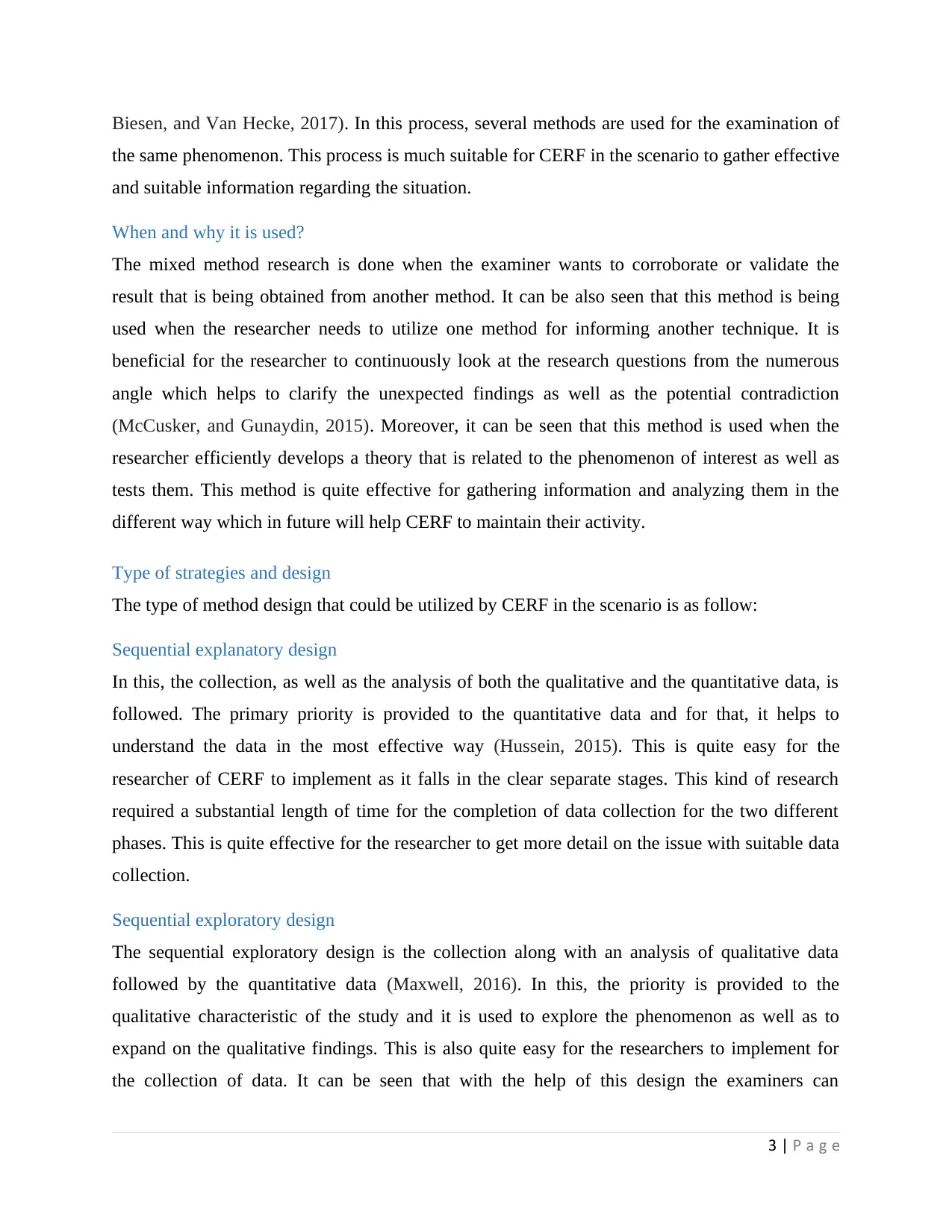
Biesen, and Van Hecke, 2017). In this process, several methods are used for the examination of
the same phenomenon. This process is much suitable for CERF in the scenario to gather effective
and suitable information regarding the situation.
When and why it is used?
The mixed method research is done when the examiner wants to corroborate or validate the
result that is being obtained from another method. It can be also seen that this method is being
used when the researcher needs to utilize one method for informing another technique. It is
beneficial for the researcher to continuously look at the research questions from the numerous
angle which helps to clarify the unexpected findings as well as the potential contradiction
(McCusker, and Gunaydin, 2015). Moreover, it can be seen that this method is used when the
researcher efficiently develops a theory that is related to the phenomenon of interest as well as
tests them. This method is quite effective for gathering information and analyzing them in the
different way which in future will help CERF to maintain their activity.
Type of strategies and design
The type of method design that could be utilized by CERF in the scenario is as follow:
Sequential explanatory design
In this, the collection, as well as the analysis of both the qualitative and the quantitative data, is
followed. The primary priority is provided to the quantitative data and for that, it helps to
understand the data in the most effective way (Hussein, 2015). This is quite easy for the
researcher of CERF to implement as it falls in the clear separate stages. This kind of research
required a substantial length of time for the completion of data collection for the two different
phases. This is quite effective for the researcher to get more detail on the issue with suitable data
collection.
Sequential exploratory design
The sequential exploratory design is the collection along with an analysis of qualitative data
followed by the quantitative data (Maxwell, 2016). In this, the priority is provided to the
qualitative characteristic of the study and it is used to explore the phenomenon as well as to
expand on the qualitative findings. This is also quite easy for the researchers to implement for
the collection of data. It can be seen that with the help of this design the examiners can
3 | P a g e
the same phenomenon. This process is much suitable for CERF in the scenario to gather effective
and suitable information regarding the situation.
When and why it is used?
The mixed method research is done when the examiner wants to corroborate or validate the
result that is being obtained from another method. It can be also seen that this method is being
used when the researcher needs to utilize one method for informing another technique. It is
beneficial for the researcher to continuously look at the research questions from the numerous
angle which helps to clarify the unexpected findings as well as the potential contradiction
(McCusker, and Gunaydin, 2015). Moreover, it can be seen that this method is used when the
researcher efficiently develops a theory that is related to the phenomenon of interest as well as
tests them. This method is quite effective for gathering information and analyzing them in the
different way which in future will help CERF to maintain their activity.
Type of strategies and design
The type of method design that could be utilized by CERF in the scenario is as follow:
Sequential explanatory design
In this, the collection, as well as the analysis of both the qualitative and the quantitative data, is
followed. The primary priority is provided to the quantitative data and for that, it helps to
understand the data in the most effective way (Hussein, 2015). This is quite easy for the
researcher of CERF to implement as it falls in the clear separate stages. This kind of research
required a substantial length of time for the completion of data collection for the two different
phases. This is quite effective for the researcher to get more detail on the issue with suitable data
collection.
Sequential exploratory design
The sequential exploratory design is the collection along with an analysis of qualitative data
followed by the quantitative data (Maxwell, 2016). In this, the priority is provided to the
qualitative characteristic of the study and it is used to explore the phenomenon as well as to
expand on the qualitative findings. This is also quite easy for the researchers to implement for
the collection of data. It can be seen that with the help of this design the examiners can
3 | P a g e
Paraphrase This Document
Need a fresh take? Get an instant paraphrase of this document with our AI Paraphraser

effectively develop as well as test the new instruments. Moreover, it can be said that this design
is very much essential for the researcher to conduct analysis with the help of gathered
information.
Concurrent Triangulation
In this design, only one data collection phase is used where the quantitative along with the
qualitative data collection as well as analysis are generally conducted separately but concurrently
(Molina-Azorín, and Font, 2016). In this, the findings are integrated at the time of interpretation
phase. It is used for development of critical understanding on the research facts. In this time
taken for the collection of data is quite less as compared to sequential design. In this great effort
as well as expertise is required to analyze the two different data in the most effective way. For
the mixed method research, this design is very much effective.
Concurrent nested
In this design also only one method of data collection is being used where the predominant
method it can be qualitative or quantitative nest the other less priority method that also can be
qualitative or quantitative (Bentahar, and Cameron, 2015). It helps to get a broader as well as in-
depth view on the research topic and also have the ability to offset the possible weakness that can
be found in the predominant method. In this two kind of data are collected simultaneously which
help to reduce the resources as well as time is taken to conduct the research.
Strength of Mixed method research
The advantages or the strength of mixed method research for CERF in the scenario are as
follows:
It helps to get strength of both the data collection method and offset their weakness for
the betterment of job (Mayoh, and Onwuegbuzie, 2015). It utilize both the strength as
well as the weakness of qualitative and quantitative method that creates the process of
two way thinking
It helps to get complete as well as comprehensive understanding of the examine problem
with the help of qualitative as well as the quantitative data (Adams, 2017)
It also help the researcher to develop more specific as well as better instrument for
understanding the collected data and to analyze them
4 | P a g e
is very much essential for the researcher to conduct analysis with the help of gathered
information.
Concurrent Triangulation
In this design, only one data collection phase is used where the quantitative along with the
qualitative data collection as well as analysis are generally conducted separately but concurrently
(Molina-Azorín, and Font, 2016). In this, the findings are integrated at the time of interpretation
phase. It is used for development of critical understanding on the research facts. In this time
taken for the collection of data is quite less as compared to sequential design. In this great effort
as well as expertise is required to analyze the two different data in the most effective way. For
the mixed method research, this design is very much effective.
Concurrent nested
In this design also only one method of data collection is being used where the predominant
method it can be qualitative or quantitative nest the other less priority method that also can be
qualitative or quantitative (Bentahar, and Cameron, 2015). It helps to get a broader as well as in-
depth view on the research topic and also have the ability to offset the possible weakness that can
be found in the predominant method. In this two kind of data are collected simultaneously which
help to reduce the resources as well as time is taken to conduct the research.
Strength of Mixed method research
The advantages or the strength of mixed method research for CERF in the scenario are as
follows:
It helps to get strength of both the data collection method and offset their weakness for
the betterment of job (Mayoh, and Onwuegbuzie, 2015). It utilize both the strength as
well as the weakness of qualitative and quantitative method that creates the process of
two way thinking
It helps to get complete as well as comprehensive understanding of the examine problem
with the help of qualitative as well as the quantitative data (Adams, 2017)
It also help the researcher to develop more specific as well as better instrument for
understanding the collected data and to analyze them
4 | P a g e
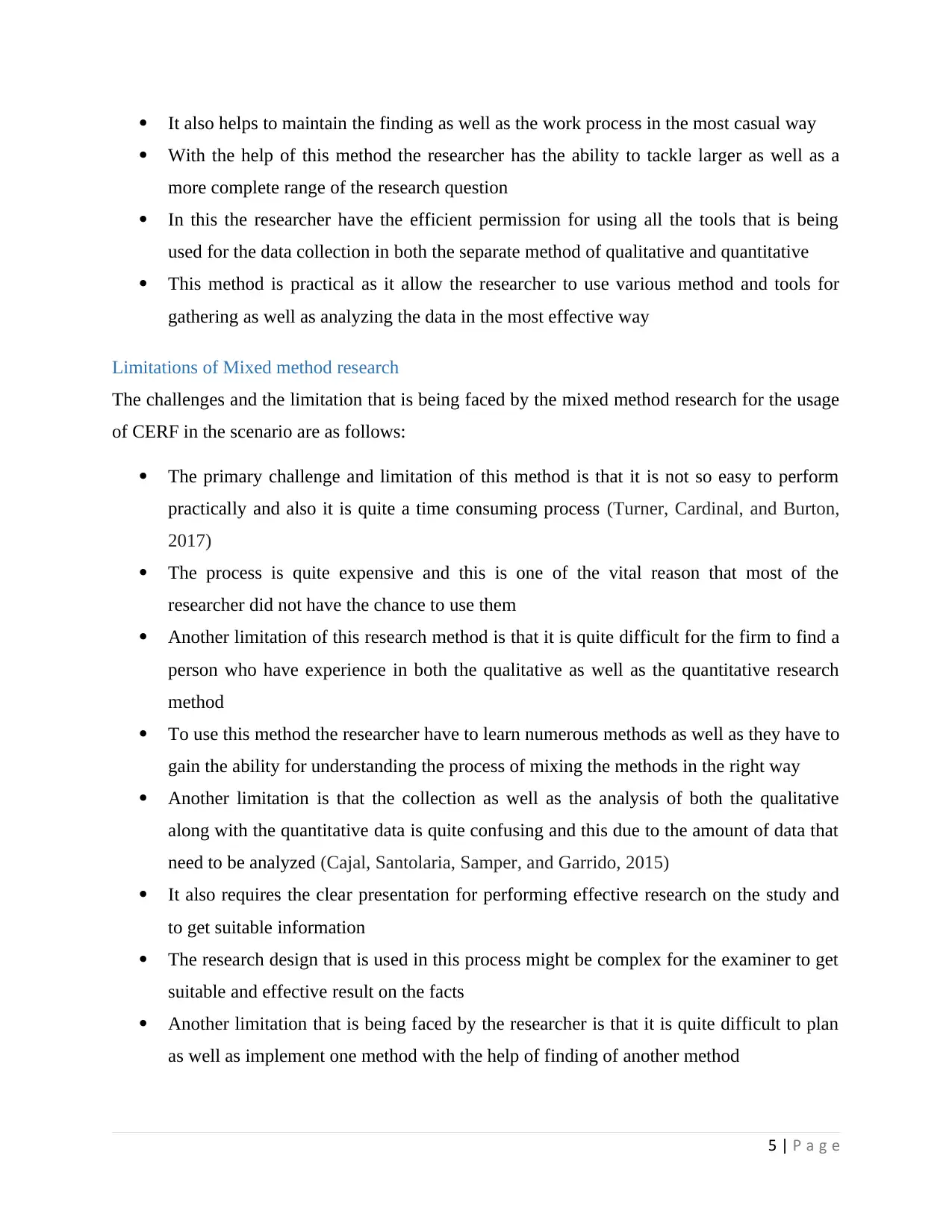
It also helps to maintain the finding as well as the work process in the most casual way
With the help of this method the researcher has the ability to tackle larger as well as a
more complete range of the research question
In this the researcher have the efficient permission for using all the tools that is being
used for the data collection in both the separate method of qualitative and quantitative
This method is practical as it allow the researcher to use various method and tools for
gathering as well as analyzing the data in the most effective way
Limitations of Mixed method research
The challenges and the limitation that is being faced by the mixed method research for the usage
of CERF in the scenario are as follows:
The primary challenge and limitation of this method is that it is not so easy to perform
practically and also it is quite a time consuming process (Turner, Cardinal, and Burton,
2017)
The process is quite expensive and this is one of the vital reason that most of the
researcher did not have the chance to use them
Another limitation of this research method is that it is quite difficult for the firm to find a
person who have experience in both the qualitative as well as the quantitative research
method
To use this method the researcher have to learn numerous methods as well as they have to
gain the ability for understanding the process of mixing the methods in the right way
Another limitation is that the collection as well as the analysis of both the qualitative
along with the quantitative data is quite confusing and this due to the amount of data that
need to be analyzed (Cajal, Santolaria, Samper, and Garrido, 2015)
It also requires the clear presentation for performing effective research on the study and
to get suitable information
The research design that is used in this process might be complex for the examiner to get
suitable and effective result on the facts
Another limitation that is being faced by the researcher is that it is quite difficult to plan
as well as implement one method with the help of finding of another method
5 | P a g e
With the help of this method the researcher has the ability to tackle larger as well as a
more complete range of the research question
In this the researcher have the efficient permission for using all the tools that is being
used for the data collection in both the separate method of qualitative and quantitative
This method is practical as it allow the researcher to use various method and tools for
gathering as well as analyzing the data in the most effective way
Limitations of Mixed method research
The challenges and the limitation that is being faced by the mixed method research for the usage
of CERF in the scenario are as follows:
The primary challenge and limitation of this method is that it is not so easy to perform
practically and also it is quite a time consuming process (Turner, Cardinal, and Burton,
2017)
The process is quite expensive and this is one of the vital reason that most of the
researcher did not have the chance to use them
Another limitation of this research method is that it is quite difficult for the firm to find a
person who have experience in both the qualitative as well as the quantitative research
method
To use this method the researcher have to learn numerous methods as well as they have to
gain the ability for understanding the process of mixing the methods in the right way
Another limitation is that the collection as well as the analysis of both the qualitative
along with the quantitative data is quite confusing and this due to the amount of data that
need to be analyzed (Cajal, Santolaria, Samper, and Garrido, 2015)
It also requires the clear presentation for performing effective research on the study and
to get suitable information
The research design that is used in this process might be complex for the examiner to get
suitable and effective result on the facts
Another limitation that is being faced by the researcher is that it is quite difficult to plan
as well as implement one method with the help of finding of another method
5 | P a g e
⊘ This is a preview!⊘
Do you want full access?
Subscribe today to unlock all pages.

Trusted by 1+ million students worldwide
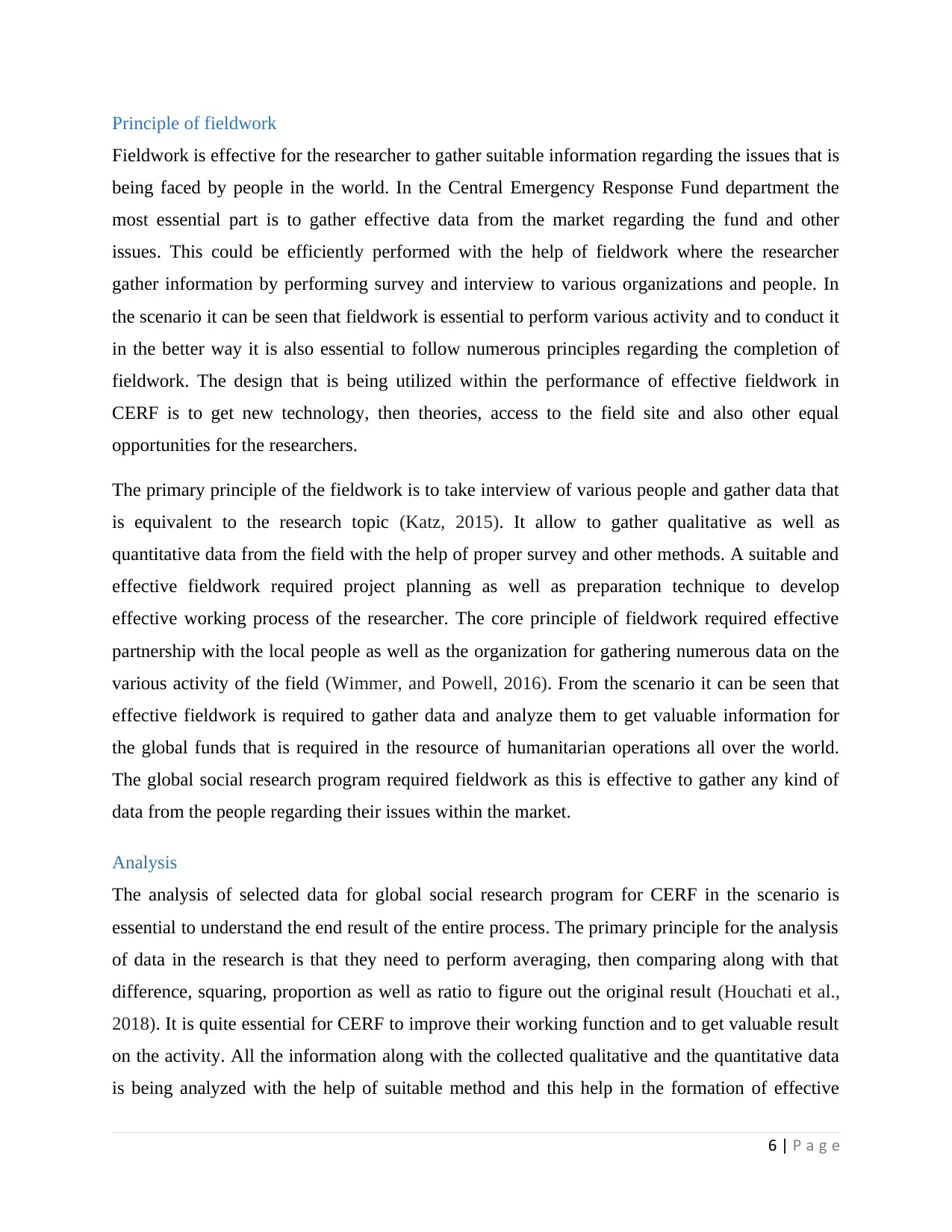
Principle of fieldwork
Fieldwork is effective for the researcher to gather suitable information regarding the issues that is
being faced by people in the world. In the Central Emergency Response Fund department the
most essential part is to gather effective data from the market regarding the fund and other
issues. This could be efficiently performed with the help of fieldwork where the researcher
gather information by performing survey and interview to various organizations and people. In
the scenario it can be seen that fieldwork is essential to perform various activity and to conduct it
in the better way it is also essential to follow numerous principles regarding the completion of
fieldwork. The design that is being utilized within the performance of effective fieldwork in
CERF is to get new technology, then theories, access to the field site and also other equal
opportunities for the researchers.
The primary principle of the fieldwork is to take interview of various people and gather data that
is equivalent to the research topic (Katz, 2015). It allow to gather qualitative as well as
quantitative data from the field with the help of proper survey and other methods. A suitable and
effective fieldwork required project planning as well as preparation technique to develop
effective working process of the researcher. The core principle of fieldwork required effective
partnership with the local people as well as the organization for gathering numerous data on the
various activity of the field (Wimmer, and Powell, 2016). From the scenario it can be seen that
effective fieldwork is required to gather data and analyze them to get valuable information for
the global funds that is required in the resource of humanitarian operations all over the world.
The global social research program required fieldwork as this is effective to gather any kind of
data from the people regarding their issues within the market.
Analysis
The analysis of selected data for global social research program for CERF in the scenario is
essential to understand the end result of the entire process. The primary principle for the analysis
of data in the research is that they need to perform averaging, then comparing along with that
difference, squaring, proportion as well as ratio to figure out the original result (Houchati et al.,
2018). It is quite essential for CERF to improve their working function and to get valuable result
on the activity. All the information along with the collected qualitative and the quantitative data
is being analyzed with the help of suitable method and this help in the formation of effective
6 | P a g e
Fieldwork is effective for the researcher to gather suitable information regarding the issues that is
being faced by people in the world. In the Central Emergency Response Fund department the
most essential part is to gather effective data from the market regarding the fund and other
issues. This could be efficiently performed with the help of fieldwork where the researcher
gather information by performing survey and interview to various organizations and people. In
the scenario it can be seen that fieldwork is essential to perform various activity and to conduct it
in the better way it is also essential to follow numerous principles regarding the completion of
fieldwork. The design that is being utilized within the performance of effective fieldwork in
CERF is to get new technology, then theories, access to the field site and also other equal
opportunities for the researchers.
The primary principle of the fieldwork is to take interview of various people and gather data that
is equivalent to the research topic (Katz, 2015). It allow to gather qualitative as well as
quantitative data from the field with the help of proper survey and other methods. A suitable and
effective fieldwork required project planning as well as preparation technique to develop
effective working process of the researcher. The core principle of fieldwork required effective
partnership with the local people as well as the organization for gathering numerous data on the
various activity of the field (Wimmer, and Powell, 2016). From the scenario it can be seen that
effective fieldwork is required to gather data and analyze them to get valuable information for
the global funds that is required in the resource of humanitarian operations all over the world.
The global social research program required fieldwork as this is effective to gather any kind of
data from the people regarding their issues within the market.
Analysis
The analysis of selected data for global social research program for CERF in the scenario is
essential to understand the end result of the entire process. The primary principle for the analysis
of data in the research is that they need to perform averaging, then comparing along with that
difference, squaring, proportion as well as ratio to figure out the original result (Houchati et al.,
2018). It is quite essential for CERF to improve their working function and to get valuable result
on the activity. All the information along with the collected qualitative and the quantitative data
is being analyzed with the help of suitable method and this help in the formation of effective
6 | P a g e
Paraphrase This Document
Need a fresh take? Get an instant paraphrase of this document with our AI Paraphraser
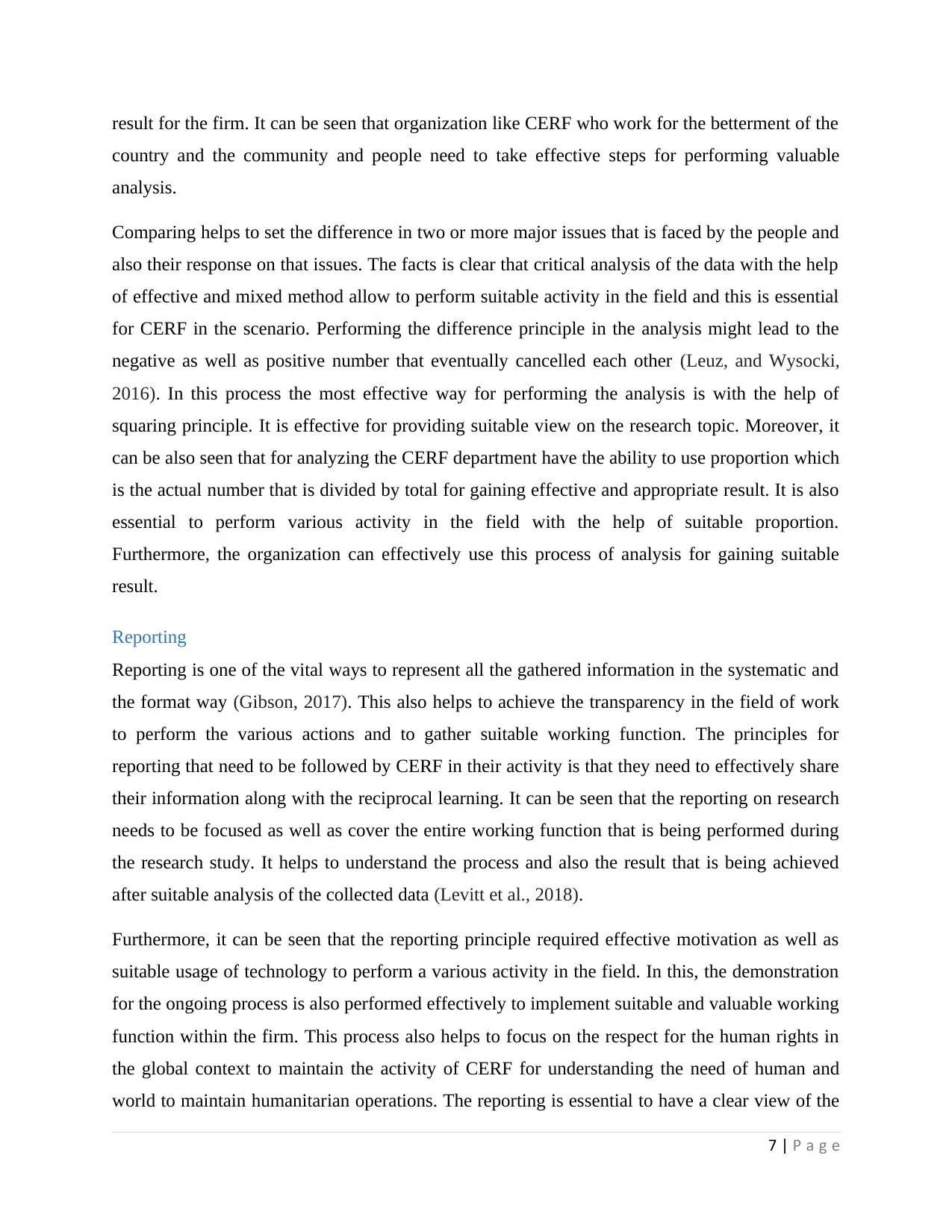
result for the firm. It can be seen that organization like CERF who work for the betterment of the
country and the community and people need to take effective steps for performing valuable
analysis.
Comparing helps to set the difference in two or more major issues that is faced by the people and
also their response on that issues. The facts is clear that critical analysis of the data with the help
of effective and mixed method allow to perform suitable activity in the field and this is essential
for CERF in the scenario. Performing the difference principle in the analysis might lead to the
negative as well as positive number that eventually cancelled each other (Leuz, and Wysocki,
2016). In this process the most effective way for performing the analysis is with the help of
squaring principle. It is effective for providing suitable view on the research topic. Moreover, it
can be also seen that for analyzing the CERF department have the ability to use proportion which
is the actual number that is divided by total for gaining effective and appropriate result. It is also
essential to perform various activity in the field with the help of suitable proportion.
Furthermore, the organization can effectively use this process of analysis for gaining suitable
result.
Reporting
Reporting is one of the vital ways to represent all the gathered information in the systematic and
the format way (Gibson, 2017). This also helps to achieve the transparency in the field of work
to perform the various actions and to gather suitable working function. The principles for
reporting that need to be followed by CERF in their activity is that they need to effectively share
their information along with the reciprocal learning. It can be seen that the reporting on research
needs to be focused as well as cover the entire working function that is being performed during
the research study. It helps to understand the process and also the result that is being achieved
after suitable analysis of the collected data (Levitt et al., 2018).
Furthermore, it can be seen that the reporting principle required effective motivation as well as
suitable usage of technology to perform a various activity in the field. In this, the demonstration
for the ongoing process is also performed effectively to implement suitable and valuable working
function within the firm. This process also helps to focus on the respect for the human rights in
the global context to maintain the activity of CERF for understanding the need of human and
world to maintain humanitarian operations. The reporting is essential to have a clear view of the
7 | P a g e
country and the community and people need to take effective steps for performing valuable
analysis.
Comparing helps to set the difference in two or more major issues that is faced by the people and
also their response on that issues. The facts is clear that critical analysis of the data with the help
of effective and mixed method allow to perform suitable activity in the field and this is essential
for CERF in the scenario. Performing the difference principle in the analysis might lead to the
negative as well as positive number that eventually cancelled each other (Leuz, and Wysocki,
2016). In this process the most effective way for performing the analysis is with the help of
squaring principle. It is effective for providing suitable view on the research topic. Moreover, it
can be also seen that for analyzing the CERF department have the ability to use proportion which
is the actual number that is divided by total for gaining effective and appropriate result. It is also
essential to perform various activity in the field with the help of suitable proportion.
Furthermore, the organization can effectively use this process of analysis for gaining suitable
result.
Reporting
Reporting is one of the vital ways to represent all the gathered information in the systematic and
the format way (Gibson, 2017). This also helps to achieve the transparency in the field of work
to perform the various actions and to gather suitable working function. The principles for
reporting that need to be followed by CERF in their activity is that they need to effectively share
their information along with the reciprocal learning. It can be seen that the reporting on research
needs to be focused as well as cover the entire working function that is being performed during
the research study. It helps to understand the process and also the result that is being achieved
after suitable analysis of the collected data (Levitt et al., 2018).
Furthermore, it can be seen that the reporting principle required effective motivation as well as
suitable usage of technology to perform a various activity in the field. In this, the demonstration
for the ongoing process is also performed effectively to implement suitable and valuable working
function within the firm. This process also helps to focus on the respect for the human rights in
the global context to maintain the activity of CERF for understanding the need of human and
world to maintain humanitarian operations. The reporting is essential to have a clear view of the
7 | P a g e

process and also monitor the limitations and the gap that might be formed in the research. With
the help of reporting the analysis of research, the gap is established and that help to determine
future research on the topic by understanding all the drawbacks and limitations in the research
paper.
8 | P a g e
the help of reporting the analysis of research, the gap is established and that help to determine
future research on the topic by understanding all the drawbacks and limitations in the research
paper.
8 | P a g e
⊘ This is a preview!⊘
Do you want full access?
Subscribe today to unlock all pages.

Trusted by 1+ million students worldwide
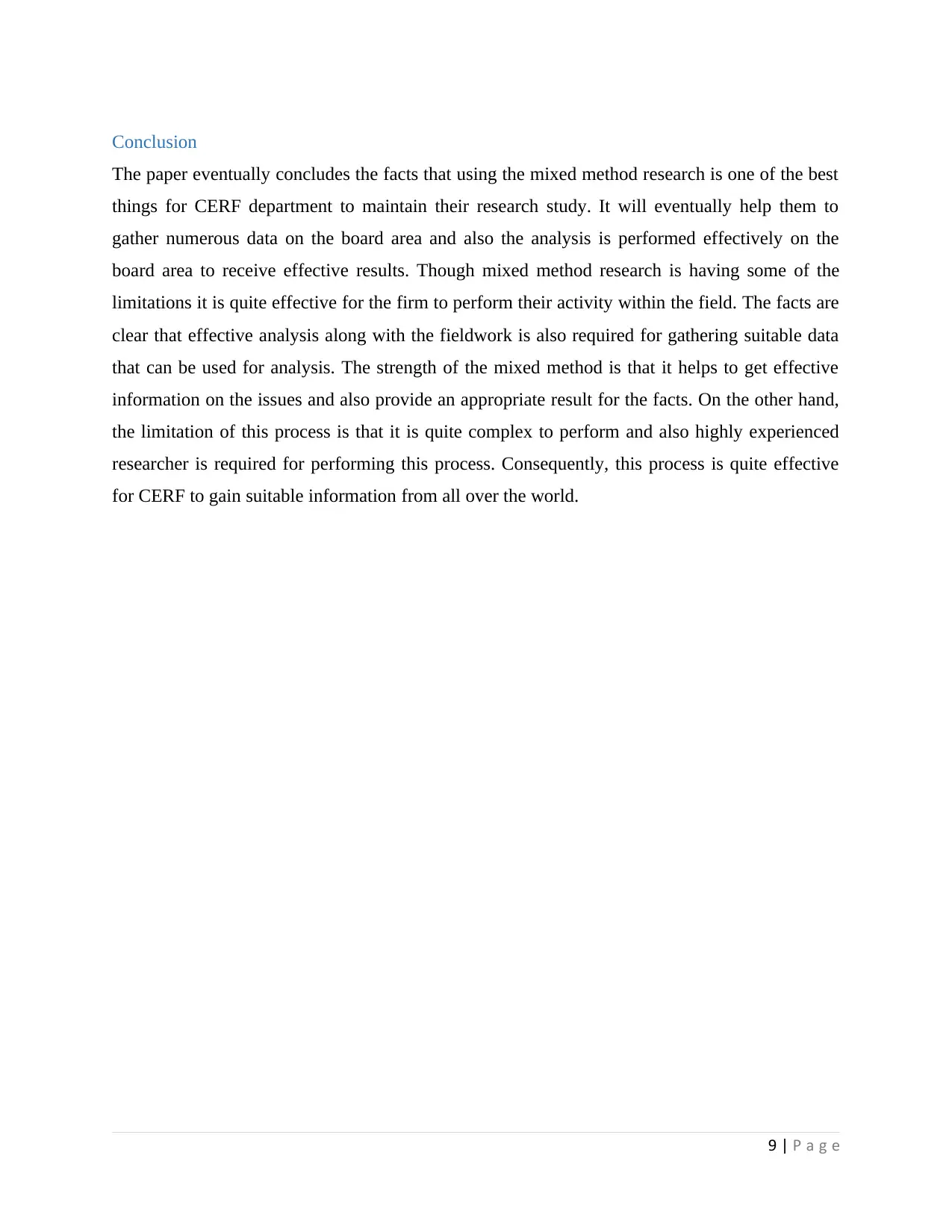
Conclusion
The paper eventually concludes the facts that using the mixed method research is one of the best
things for CERF department to maintain their research study. It will eventually help them to
gather numerous data on the board area and also the analysis is performed effectively on the
board area to receive effective results. Though mixed method research is having some of the
limitations it is quite effective for the firm to perform their activity within the field. The facts are
clear that effective analysis along with the fieldwork is also required for gathering suitable data
that can be used for analysis. The strength of the mixed method is that it helps to get effective
information on the issues and also provide an appropriate result for the facts. On the other hand,
the limitation of this process is that it is quite complex to perform and also highly experienced
researcher is required for performing this process. Consequently, this process is quite effective
for CERF to gain suitable information from all over the world.
9 | P a g e
The paper eventually concludes the facts that using the mixed method research is one of the best
things for CERF department to maintain their research study. It will eventually help them to
gather numerous data on the board area and also the analysis is performed effectively on the
board area to receive effective results. Though mixed method research is having some of the
limitations it is quite effective for the firm to perform their activity within the field. The facts are
clear that effective analysis along with the fieldwork is also required for gathering suitable data
that can be used for analysis. The strength of the mixed method is that it helps to get effective
information on the issues and also provide an appropriate result for the facts. On the other hand,
the limitation of this process is that it is quite complex to perform and also highly experienced
researcher is required for performing this process. Consequently, this process is quite effective
for CERF to gain suitable information from all over the world.
9 | P a g e
Paraphrase This Document
Need a fresh take? Get an instant paraphrase of this document with our AI Paraphraser
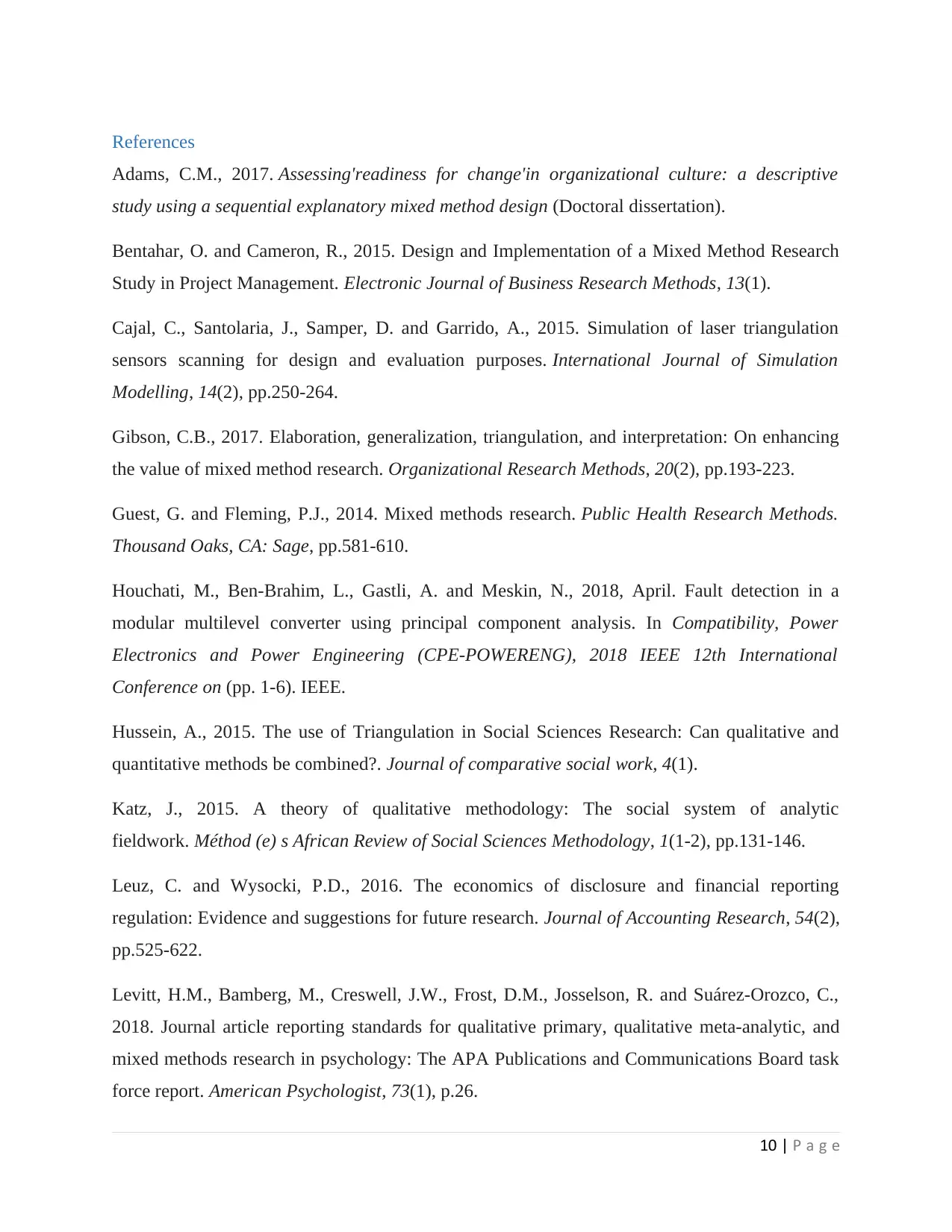
References
Adams, C.M., 2017. Assessing'readiness for change'in organizational culture: a descriptive
study using a sequential explanatory mixed method design (Doctoral dissertation).
Bentahar, O. and Cameron, R., 2015. Design and Implementation of a Mixed Method Research
Study in Project Management. Electronic Journal of Business Research Methods, 13(1).
Cajal, C., Santolaria, J., Samper, D. and Garrido, A., 2015. Simulation of laser triangulation
sensors scanning for design and evaluation purposes. International Journal of Simulation
Modelling, 14(2), pp.250-264.
Gibson, C.B., 2017. Elaboration, generalization, triangulation, and interpretation: On enhancing
the value of mixed method research. Organizational Research Methods, 20(2), pp.193-223.
Guest, G. and Fleming, P.J., 2014. Mixed methods research. Public Health Research Methods.
Thousand Oaks, CA: Sage, pp.581-610.
Houchati, M., Ben-Brahim, L., Gastli, A. and Meskin, N., 2018, April. Fault detection in a
modular multilevel converter using principal component analysis. In Compatibility, Power
Electronics and Power Engineering (CPE-POWERENG), 2018 IEEE 12th International
Conference on (pp. 1-6). IEEE.
Hussein, A., 2015. The use of Triangulation in Social Sciences Research: Can qualitative and
quantitative methods be combined?. Journal of comparative social work, 4(1).
Katz, J., 2015. A theory of qualitative methodology: The social system of analytic
fieldwork. Méthod (e) s African Review of Social Sciences Methodology, 1(1-2), pp.131-146.
Leuz, C. and Wysocki, P.D., 2016. The economics of disclosure and financial reporting
regulation: Evidence and suggestions for future research. Journal of Accounting Research, 54(2),
pp.525-622.
Levitt, H.M., Bamberg, M., Creswell, J.W., Frost, D.M., Josselson, R. and Suárez-Orozco, C.,
2018. Journal article reporting standards for qualitative primary, qualitative meta-analytic, and
mixed methods research in psychology: The APA Publications and Communications Board task
force report. American Psychologist, 73(1), p.26.
10 | P a g e
Adams, C.M., 2017. Assessing'readiness for change'in organizational culture: a descriptive
study using a sequential explanatory mixed method design (Doctoral dissertation).
Bentahar, O. and Cameron, R., 2015. Design and Implementation of a Mixed Method Research
Study in Project Management. Electronic Journal of Business Research Methods, 13(1).
Cajal, C., Santolaria, J., Samper, D. and Garrido, A., 2015. Simulation of laser triangulation
sensors scanning for design and evaluation purposes. International Journal of Simulation
Modelling, 14(2), pp.250-264.
Gibson, C.B., 2017. Elaboration, generalization, triangulation, and interpretation: On enhancing
the value of mixed method research. Organizational Research Methods, 20(2), pp.193-223.
Guest, G. and Fleming, P.J., 2014. Mixed methods research. Public Health Research Methods.
Thousand Oaks, CA: Sage, pp.581-610.
Houchati, M., Ben-Brahim, L., Gastli, A. and Meskin, N., 2018, April. Fault detection in a
modular multilevel converter using principal component analysis. In Compatibility, Power
Electronics and Power Engineering (CPE-POWERENG), 2018 IEEE 12th International
Conference on (pp. 1-6). IEEE.
Hussein, A., 2015. The use of Triangulation in Social Sciences Research: Can qualitative and
quantitative methods be combined?. Journal of comparative social work, 4(1).
Katz, J., 2015. A theory of qualitative methodology: The social system of analytic
fieldwork. Méthod (e) s African Review of Social Sciences Methodology, 1(1-2), pp.131-146.
Leuz, C. and Wysocki, P.D., 2016. The economics of disclosure and financial reporting
regulation: Evidence and suggestions for future research. Journal of Accounting Research, 54(2),
pp.525-622.
Levitt, H.M., Bamberg, M., Creswell, J.W., Frost, D.M., Josselson, R. and Suárez-Orozco, C.,
2018. Journal article reporting standards for qualitative primary, qualitative meta-analytic, and
mixed methods research in psychology: The APA Publications and Communications Board task
force report. American Psychologist, 73(1), p.26.
10 | P a g e
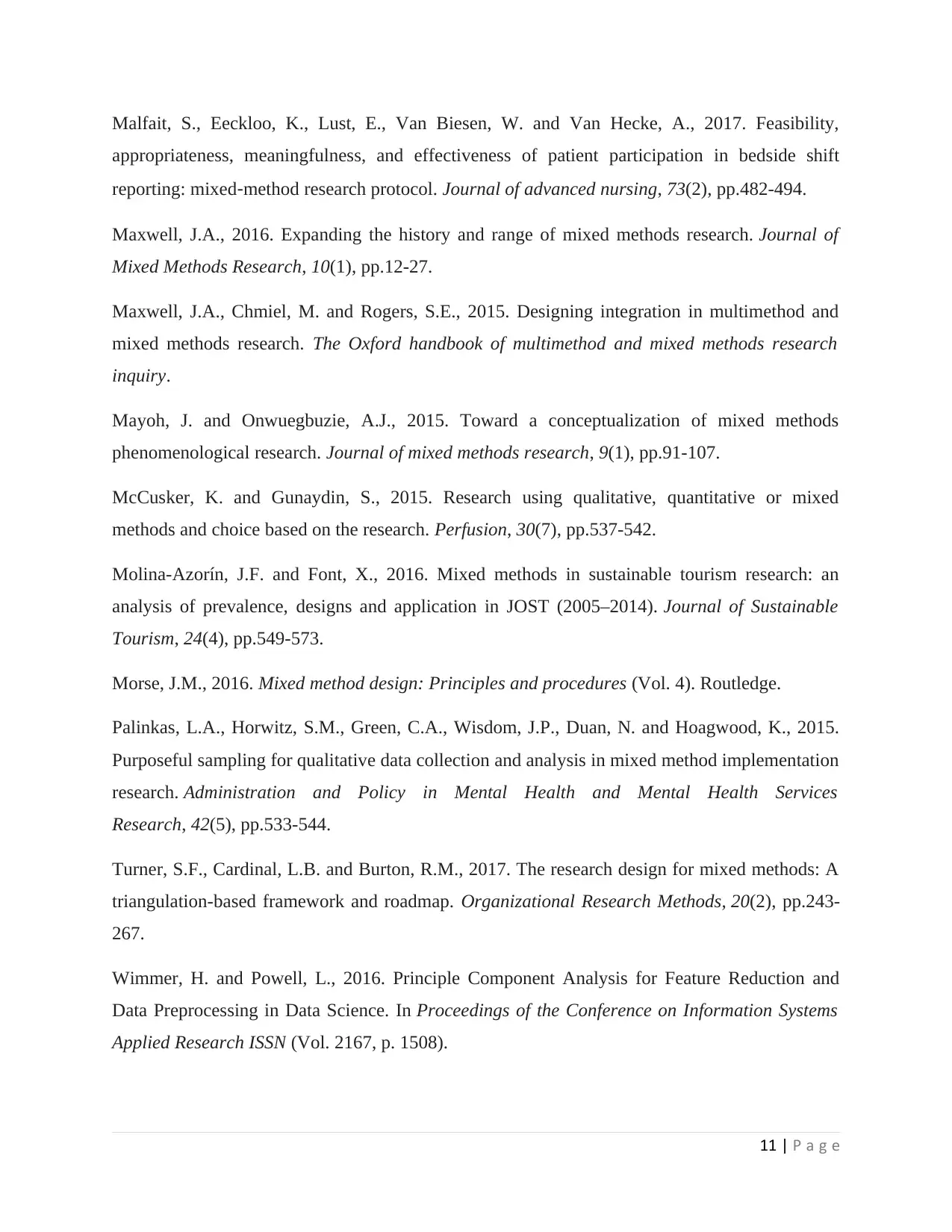
Malfait, S., Eeckloo, K., Lust, E., Van Biesen, W. and Van Hecke, A., 2017. Feasibility,
appropriateness, meaningfulness, and effectiveness of patient participation in bedside shift
reporting: mixed‐method research protocol. Journal of advanced nursing, 73(2), pp.482-494.
Maxwell, J.A., 2016. Expanding the history and range of mixed methods research. Journal of
Mixed Methods Research, 10(1), pp.12-27.
Maxwell, J.A., Chmiel, M. and Rogers, S.E., 2015. Designing integration in multimethod and
mixed methods research. The Oxford handbook of multimethod and mixed methods research
inquiry.
Mayoh, J. and Onwuegbuzie, A.J., 2015. Toward a conceptualization of mixed methods
phenomenological research. Journal of mixed methods research, 9(1), pp.91-107.
McCusker, K. and Gunaydin, S., 2015. Research using qualitative, quantitative or mixed
methods and choice based on the research. Perfusion, 30(7), pp.537-542.
Molina-Azorín, J.F. and Font, X., 2016. Mixed methods in sustainable tourism research: an
analysis of prevalence, designs and application in JOST (2005–2014). Journal of Sustainable
Tourism, 24(4), pp.549-573.
Morse, J.M., 2016. Mixed method design: Principles and procedures (Vol. 4). Routledge.
Palinkas, L.A., Horwitz, S.M., Green, C.A., Wisdom, J.P., Duan, N. and Hoagwood, K., 2015.
Purposeful sampling for qualitative data collection and analysis in mixed method implementation
research. Administration and Policy in Mental Health and Mental Health Services
Research, 42(5), pp.533-544.
Turner, S.F., Cardinal, L.B. and Burton, R.M., 2017. The research design for mixed methods: A
triangulation-based framework and roadmap. Organizational Research Methods, 20(2), pp.243-
267.
Wimmer, H. and Powell, L., 2016. Principle Component Analysis for Feature Reduction and
Data Preprocessing in Data Science. In Proceedings of the Conference on Information Systems
Applied Research ISSN (Vol. 2167, p. 1508).
11 | P a g e
appropriateness, meaningfulness, and effectiveness of patient participation in bedside shift
reporting: mixed‐method research protocol. Journal of advanced nursing, 73(2), pp.482-494.
Maxwell, J.A., 2016. Expanding the history and range of mixed methods research. Journal of
Mixed Methods Research, 10(1), pp.12-27.
Maxwell, J.A., Chmiel, M. and Rogers, S.E., 2015. Designing integration in multimethod and
mixed methods research. The Oxford handbook of multimethod and mixed methods research
inquiry.
Mayoh, J. and Onwuegbuzie, A.J., 2015. Toward a conceptualization of mixed methods
phenomenological research. Journal of mixed methods research, 9(1), pp.91-107.
McCusker, K. and Gunaydin, S., 2015. Research using qualitative, quantitative or mixed
methods and choice based on the research. Perfusion, 30(7), pp.537-542.
Molina-Azorín, J.F. and Font, X., 2016. Mixed methods in sustainable tourism research: an
analysis of prevalence, designs and application in JOST (2005–2014). Journal of Sustainable
Tourism, 24(4), pp.549-573.
Morse, J.M., 2016. Mixed method design: Principles and procedures (Vol. 4). Routledge.
Palinkas, L.A., Horwitz, S.M., Green, C.A., Wisdom, J.P., Duan, N. and Hoagwood, K., 2015.
Purposeful sampling for qualitative data collection and analysis in mixed method implementation
research. Administration and Policy in Mental Health and Mental Health Services
Research, 42(5), pp.533-544.
Turner, S.F., Cardinal, L.B. and Burton, R.M., 2017. The research design for mixed methods: A
triangulation-based framework and roadmap. Organizational Research Methods, 20(2), pp.243-
267.
Wimmer, H. and Powell, L., 2016. Principle Component Analysis for Feature Reduction and
Data Preprocessing in Data Science. In Proceedings of the Conference on Information Systems
Applied Research ISSN (Vol. 2167, p. 1508).
11 | P a g e
⊘ This is a preview!⊘
Do you want full access?
Subscribe today to unlock all pages.

Trusted by 1+ million students worldwide
1 out of 12